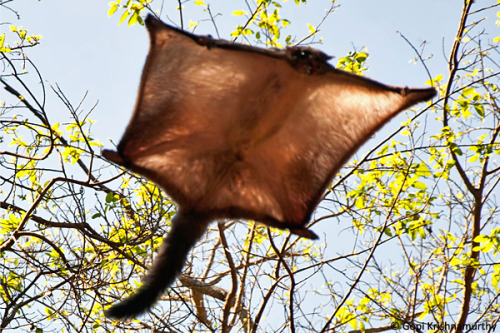libutron: Indian Giant Flying Squirrel - Petaurista philippensis Indian Giant Flying Squirrels,
libutron: Indian Giant Flying Squirrel - Petaurista philippensis Indian Giant Flying Squirrels, Petaurista philippensis (Rodentia - Sciuridae) vary in color from grey to coffee-brown with a mottled back, a grey tail and pale undersides. They feed on fruits and leaves and have a fondness for fig fruits. They nest mostly in tree cavities and are found in a mosaic of forests of tall trees and plantations. When dusk falls, they leave their nests and return only before dawn. Glides of flying squirrels are a thrill to watch. Gliding has been the subject of much research, as some scientists believe it may be a precursor to powered flight. Two membranes, one between the wrist and the ankle and another from their wrist to neck are what help them achieve the feat of gliding. Large flying squirrels like the Indian Giant Flying Squirrel have an additional membrane between their tail and hind limbs. To glide, the flying squirrel climbs high up a tree to the upper canopy and jumps down. It then stretches its gliding membranes taut with the help of a cartilaginous wrist bone so that aided by the force of lift, it glides spread-eagle along an oblong trajectory. While air borne, it uses its tail to manoeuvre and then billows its gliding membranes outwards to decelerate so that it can land lightly. A vertical trunk is usually picked for landing when glides are long. Indian Giant Flying Squirrels have been known to cover distances as great as 90m in a single glide, although they prefer shorter glides. They also prefer climbing across tree branches when distances between trees are short. Petaurista philippensis is widely distributed in South Asia, southern and central China, and mainland Southeast Asia. References: [1] - [2] Photo credit: ©Gopi Krishnamurthy | Locality: Dandeli, Uttara Kannada, Karnataka, India -- source link

